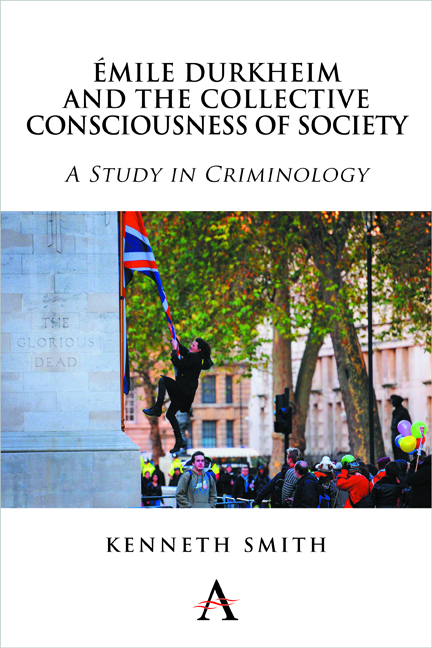Book contents
- Frontmatter
- Dedication
- Contents
- Epigraph
- Preface
- Introduction
- Part I The Concept of the Collective Consciousness of Society
- Part II The Form of the Collective Consciousness
- Part III Durkheim on Crime and Punishment
- Preface to Part III
- Introduction to Part III
- 8 Durkheim on Crime and Punishment in The Division of Labour in Society
- 9 Durkheim on Crime and Punishment in The Rules of Sociological Method
- 10 Interregnum on Suicide (1897)
- 11 Durkheim's Undeservedly Famous ‘Two Laws of Penal Evolution’ Essay (1901)
- 12 Durkheim on Crime and Punishment in Moral Education (1902-03)
- Conclusion to Part III
- Part IV Social Fact or Social Phenomenon? Durkheim's Concept of the Collective Consciousness as a ‘Social Fact’
- Part V Some Problems with Durkheim's Concept of the Common and Collective Consciousness
- Conclusion
- Appendix: On Paying a Debt to Society
- Notes
- References
- Index
10 - Interregnum on Suicide (1897)
from Part III - Durkheim on Crime and Punishment
Published online by Cambridge University Press: 05 October 2014
- Frontmatter
- Dedication
- Contents
- Epigraph
- Preface
- Introduction
- Part I The Concept of the Collective Consciousness of Society
- Part II The Form of the Collective Consciousness
- Part III Durkheim on Crime and Punishment
- Preface to Part III
- Introduction to Part III
- 8 Durkheim on Crime and Punishment in The Division of Labour in Society
- 9 Durkheim on Crime and Punishment in The Rules of Sociological Method
- 10 Interregnum on Suicide (1897)
- 11 Durkheim's Undeservedly Famous ‘Two Laws of Penal Evolution’ Essay (1901)
- 12 Durkheim on Crime and Punishment in Moral Education (1902-03)
- Conclusion to Part III
- Part IV Social Fact or Social Phenomenon? Durkheim's Concept of the Collective Consciousness as a ‘Social Fact’
- Part V Some Problems with Durkheim's Concept of the Common and Collective Consciousness
- Conclusion
- Appendix: On Paying a Debt to Society
- Notes
- References
- Index
Summary
Durkheim's next book after The Rules was his Le suicide, first published in France in 1897. From our present perspective, Suicide is a remarkable book, not for what it has to say about its intended subject matter, but for how little it has to say about either the concept of the collective consciousness of society or the concepts of crime and punishment generally. There is also, as I say, no mention of either the concept of mechanical or organic solidarity – although there is a certain amount of talk of organic and inorganic conditions in society – but instead the argument about pathology and morphology is restated here almost word for word from The Rules. I have already cited in Part I of this study what Durkheim has to say in Suicide on the subject of the common and collective consciousness and this does not need to be repeated here. What we can do here however is look very briefly at what Durkheim has to say on the subject of suicide as a crime – and it is remarkable how little he has to say about this subject given his interest in crime and punishment in his earlier work – and we will also look in detail at what he has to say here about the possibility that crime is morphological for societies characterized by organic solidarity.
- Type
- Chapter
- Information
- Émile Durkheim and the Collective Consciousness of Society , pp. 113 - 115Publisher: Anthem PressPrint publication year: 2014

